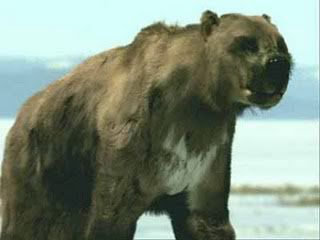Post by grrraaahhh on Sept 26, 2011 7:54:04 GMT -9
In a recent dramatic case, bears from Big Bend National Park, an isolated population in southwestern Texas, made long-range movements to Chihuahua and Coahuila, Mexico, apparently in search of better fall mast. Such movements, especially in fall, are not unusual for black bears, but in this case most of the bears never returned; they either stayed in Mexico, died naturally when crossing the desert, or were poached. As a result, the entire population was reduced to 5–7 bears, including only 2 adult females (Hellgren et al. 2005). Since then, the population has rebounded, possibly by bears immigrating back. Other examples exist where small, seemingly isolated populations have persisted and even grown, from a combination of reproduction and occasional immigration events (Doan-Crider and Hellgren 1996, Onorato et al. 2004).
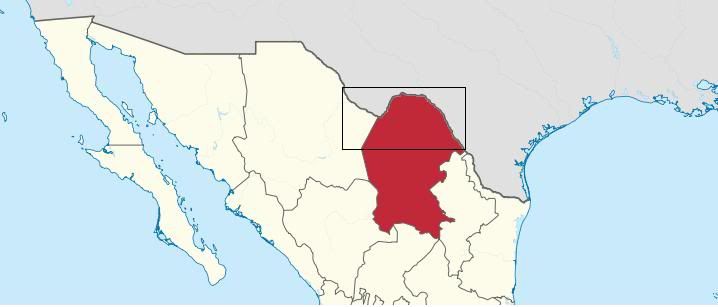
Northeastern Mexico (Coahuila: Sierra del Carmen range) & southwestern Texas (Big Bend National Park, BIBE)
black bear range.

Ursus americanus, Black Bear, Chisos Basin Window Trail, Big Bend National Park, Brewster County
Texas.
www.flickr.com/photos/tdavenport/5240530690/
Home range and habitat use of American black bears on a desert montane island in Texas
Abstract
American black bears (Ursus americanus) have recolonized Big Bend National Park (BIBE), Texas, in the past 15 years from adjacent habitat in northern Mexico. Range expansion by the Big Bend bear population across the Chihuahuan desert landscape has considerable consequences for the recolonization of areas north of BIBE in western Texas (Glass, Del Norte, and Davis Mountains). We studied black bear ecology from 1998 to 2001 in BIBE. Thirty bears were marked (15 with radiocollars) during the study, including newborn cubs. Home ranges of bears (males mean = 97.7 35.8 km2, females mean = 32.1 4.3 km2) were larger than in southwestern populations in Arizona and northern Mexico, but smaller than those in the nearby Black Gap Wildlife Management Area (BGMWA). Bears were mainly restricted to the Chisos Mountains and their foothills, with 65% of radiolocations in the pinyon (Pinus cembroides)?oak (Quercus spp.)?juniper (Juniperus spp.)?talus?meadow-grass vegetation association. Habitat selection analyses indicated that bears used oak-dominated vegetation types more than expected based upon availability. Bears were more likely than random to be <100 m from anthropogenic features (e.g., roads, trails), but that effect was much stronger in summer when visitor use was low. These data provide predictive capability to managers regarding recolonization of other montane islands north of BIBE and provide information that will help managers ensure the persistence of the small island population of black bears in BIBE.
PDF LINK: www.google.com/url?sa=t&source=web&cd=1&ved=0CCEQFjAA&url=http%3A%2F%2Fwww.bearbiology.com%2Ffileadmin%2Ftpl%2FDownloads%2FURSUS%2FVol_14_2%2FOnorato_Hellgren_14_2.pdf&rct=j&q=Home%20range%20and%20habitat%20use%20of%20American%20black%20bears%20on%20a%20desert%20montane%20island%20in%20Texas&ei=Zed_ToHfNMnx0gHEhuTuDw&usg=AFQjCNG-1HEVXPk8JHyNSoWW6V_buvPong&cad=rja
Black Bear at West Texas Deer Feeder
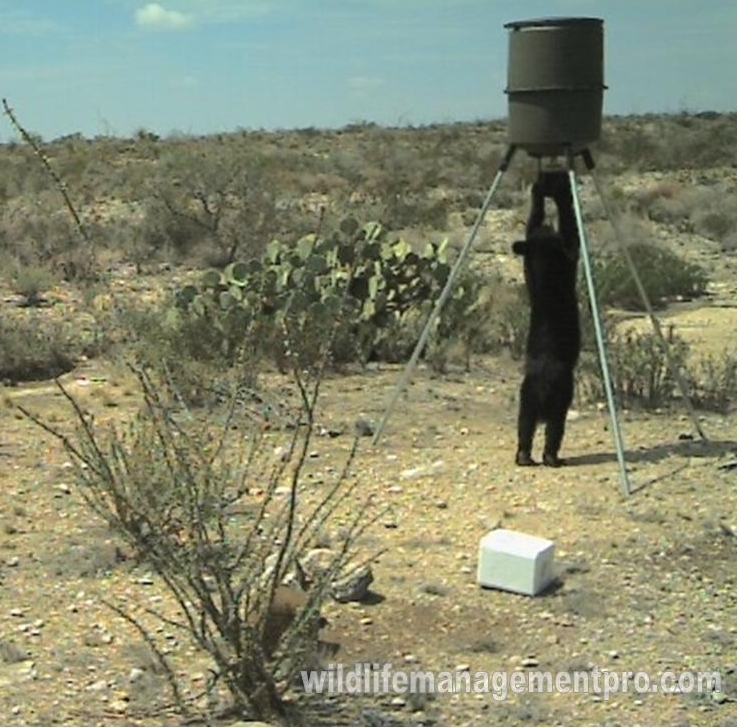
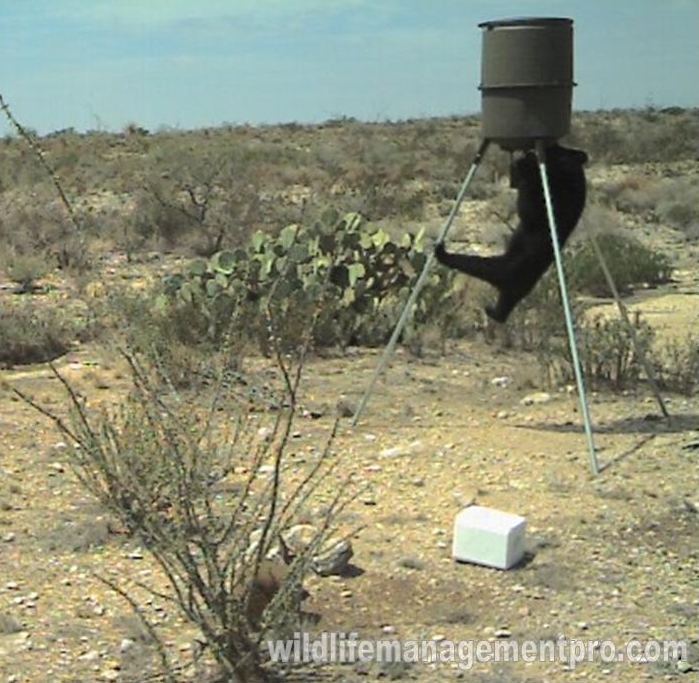
www.wildlifemanagementpro.com/2008/01/28/black-bear-at-west-texas-deer-feeder/
Population characteristics and winter ecology of black bears in Coahuila, Mexico
Biology, status, and distribution of black bears (Ursus americanus) in Mexico are poorly understood. We studied a population of black bears in the Serranias del Burro, Coahuila, Mexico, from 1991 to 1994 to address the hypothesis that the recolonization source for bears in Texas is the Sierra del Carmen range in northern Mexico. We also described aspects of winter ecology in this southerly population. We captured 42 bears (27 M, 15 F) and equipped 28 with radiotransmitters. All pregnant females (n = 13) and 2 of 5 females with yearlings denned, whereas all other bears, including 10 males, remained active during winter. Mean ( plus or minus SE) den entry and exit dates for pregnant females (n = 5) were 25 December ( plus or minus 5 days) and 22 April ( plus or minus 2 days). Mean age at primiparity was 4.5 plus or minus 0.6 years (n = 4), interbirth interval was 2.0 plus or minus 0.0 years (n = 3), and litter size was 2.75 plus or minus 0.25 cubs/female (n = 12). Estimated adult female and cub annual survival rates were 0.94 plus or minus 0.05 and 0.81 plus or minus 0.10, respectively, based on radiotelemetry and observation of family groups. Estimates of subadult male survival ranged from 0.88 plus or minus 0.08 to 1.00 plus or minus 0.00. We estimated density to be 0.35 bears/km super(2) using a modification of the Lincoln-Petersen estimator that employs animal-equivalents. Because of high reproductive rates and lack of anthropogenic mortality, our data were consistent with the hypothesis that the area can serve as a source of bears emigrating to western Texas. Future bear research in this region should focus on determination of the source of emigrating bears, and identification and conservation of corridors linking Mexican and Texan populations of black bears.
md1.csa.com/partners/viewrecord.php?requester=gs&collection=ENV&recid=3939773&q=&uid=790961554&setcookie=yes
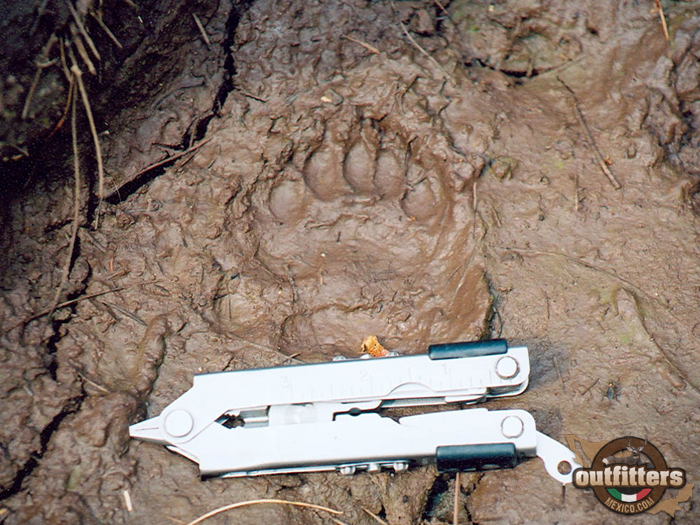
Paw print, Ursus americanus, Sierra del Carmen, Coahuila, México.
www.flickr.com/photos/outfittersmexico/3130222474/

www.nationalgeographicstock.com/ngsimages/explore/explorecomp.jsf?xsys=SE&id=1291623

www.nationalgeographicstock.com/ngsimages/explore/explorecomp.jsf?xsys=SE&id=1291622
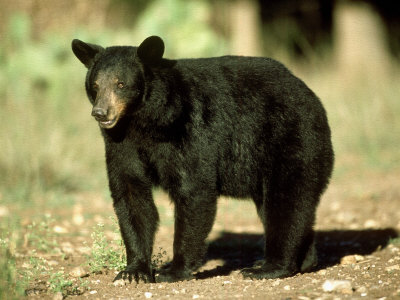
Ursus americanus, Sierra del Carmen, Coahuila, México.
Black bear abundance, habitat use, and food habits in the Sierra San Luis, Sonora, Mexico
Description: We studied black bears to determine habitat use, food habits, and abundance between April 2002 and November 2003 in the Sierra San Luis, Sonora. We utilized transects to determine spoor presence, camera traps for abundance, and scat analysis. During 2002, bears fed principally on plant material, and for 2003 on animal matter, namely livestock. Habitat use differed between years and seasons. In general terms, we recorded black bears more frequently during 2002 than 2003, attributing this change to a lack of resources, fruits, and water in our study area.
PDF LINK: www.google.com/url?sa=t&source=web&cd=2&ved=0CCQQFjAB&url=http%3A%2F%2Fwww.fs.fed.us%2Frm%2Fpubs%2Frmrs_p036%2Frmrs_p036_444_448.pdf&rct=j&q=Black%20bear%20abundance%2C%20habitat%20use%2C%20and%20food%20habits%20in%20the.%20Sierra%20San%20Luis&ei=ruN_TpGoFOfi0QHyvfntDw&usg=AFQjCNHghUdfwkMWjIA5wek-IP8pOnA0TA&cad=rja

Northeastern Mexico (Coahuila: Sierra del Carmen range) & southwestern Texas (Big Bend National Park, BIBE)
black bear range.

Ursus americanus, Black Bear, Chisos Basin Window Trail, Big Bend National Park, Brewster County
Texas.
www.flickr.com/photos/tdavenport/5240530690/
Home range and habitat use of American black bears on a desert montane island in Texas
Abstract
American black bears (Ursus americanus) have recolonized Big Bend National Park (BIBE), Texas, in the past 15 years from adjacent habitat in northern Mexico. Range expansion by the Big Bend bear population across the Chihuahuan desert landscape has considerable consequences for the recolonization of areas north of BIBE in western Texas (Glass, Del Norte, and Davis Mountains). We studied black bear ecology from 1998 to 2001 in BIBE. Thirty bears were marked (15 with radiocollars) during the study, including newborn cubs. Home ranges of bears (males mean = 97.7 35.8 km2, females mean = 32.1 4.3 km2) were larger than in southwestern populations in Arizona and northern Mexico, but smaller than those in the nearby Black Gap Wildlife Management Area (BGMWA). Bears were mainly restricted to the Chisos Mountains and their foothills, with 65% of radiolocations in the pinyon (Pinus cembroides)?oak (Quercus spp.)?juniper (Juniperus spp.)?talus?meadow-grass vegetation association. Habitat selection analyses indicated that bears used oak-dominated vegetation types more than expected based upon availability. Bears were more likely than random to be <100 m from anthropogenic features (e.g., roads, trails), but that effect was much stronger in summer when visitor use was low. These data provide predictive capability to managers regarding recolonization of other montane islands north of BIBE and provide information that will help managers ensure the persistence of the small island population of black bears in BIBE.
PDF LINK: www.google.com/url?sa=t&source=web&cd=1&ved=0CCEQFjAA&url=http%3A%2F%2Fwww.bearbiology.com%2Ffileadmin%2Ftpl%2FDownloads%2FURSUS%2FVol_14_2%2FOnorato_Hellgren_14_2.pdf&rct=j&q=Home%20range%20and%20habitat%20use%20of%20American%20black%20bears%20on%20a%20desert%20montane%20island%20in%20Texas&ei=Zed_ToHfNMnx0gHEhuTuDw&usg=AFQjCNG-1HEVXPk8JHyNSoWW6V_buvPong&cad=rja
Black Bear at West Texas Deer Feeder


www.wildlifemanagementpro.com/2008/01/28/black-bear-at-west-texas-deer-feeder/
Population characteristics and winter ecology of black bears in Coahuila, Mexico
Biology, status, and distribution of black bears (Ursus americanus) in Mexico are poorly understood. We studied a population of black bears in the Serranias del Burro, Coahuila, Mexico, from 1991 to 1994 to address the hypothesis that the recolonization source for bears in Texas is the Sierra del Carmen range in northern Mexico. We also described aspects of winter ecology in this southerly population. We captured 42 bears (27 M, 15 F) and equipped 28 with radiotransmitters. All pregnant females (n = 13) and 2 of 5 females with yearlings denned, whereas all other bears, including 10 males, remained active during winter. Mean ( plus or minus SE) den entry and exit dates for pregnant females (n = 5) were 25 December ( plus or minus 5 days) and 22 April ( plus or minus 2 days). Mean age at primiparity was 4.5 plus or minus 0.6 years (n = 4), interbirth interval was 2.0 plus or minus 0.0 years (n = 3), and litter size was 2.75 plus or minus 0.25 cubs/female (n = 12). Estimated adult female and cub annual survival rates were 0.94 plus or minus 0.05 and 0.81 plus or minus 0.10, respectively, based on radiotelemetry and observation of family groups. Estimates of subadult male survival ranged from 0.88 plus or minus 0.08 to 1.00 plus or minus 0.00. We estimated density to be 0.35 bears/km super(2) using a modification of the Lincoln-Petersen estimator that employs animal-equivalents. Because of high reproductive rates and lack of anthropogenic mortality, our data were consistent with the hypothesis that the area can serve as a source of bears emigrating to western Texas. Future bear research in this region should focus on determination of the source of emigrating bears, and identification and conservation of corridors linking Mexican and Texan populations of black bears.
md1.csa.com/partners/viewrecord.php?requester=gs&collection=ENV&recid=3939773&q=&uid=790961554&setcookie=yes

Paw print, Ursus americanus, Sierra del Carmen, Coahuila, México.
www.flickr.com/photos/outfittersmexico/3130222474/

www.nationalgeographicstock.com/ngsimages/explore/explorecomp.jsf?xsys=SE&id=1291623

www.nationalgeographicstock.com/ngsimages/explore/explorecomp.jsf?xsys=SE&id=1291622

Ursus americanus, Sierra del Carmen, Coahuila, México.
Black bear abundance, habitat use, and food habits in the Sierra San Luis, Sonora, Mexico
Description: We studied black bears to determine habitat use, food habits, and abundance between April 2002 and November 2003 in the Sierra San Luis, Sonora. We utilized transects to determine spoor presence, camera traps for abundance, and scat analysis. During 2002, bears fed principally on plant material, and for 2003 on animal matter, namely livestock. Habitat use differed between years and seasons. In general terms, we recorded black bears more frequently during 2002 than 2003, attributing this change to a lack of resources, fruits, and water in our study area.
PDF LINK: www.google.com/url?sa=t&source=web&cd=2&ved=0CCQQFjAB&url=http%3A%2F%2Fwww.fs.fed.us%2Frm%2Fpubs%2Frmrs_p036%2Frmrs_p036_444_448.pdf&rct=j&q=Black%20bear%20abundance%2C%20habitat%20use%2C%20and%20food%20habits%20in%20the.%20Sierra%20San%20Luis&ei=ruN_TpGoFOfi0QHyvfntDw&usg=AFQjCNHghUdfwkMWjIA5wek-IP8pOnA0TA&cad=rja

